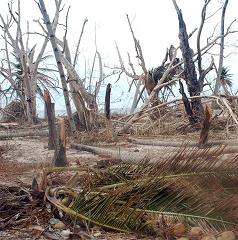ISLAND CONSERVATION-A serious blow |08 January 2007

Cyclone Bondo, a category 4 intense tropical cyclone with winds in excess of 222 kilometres
We flew over Providence en route. It looked like a bomb had hit it. The scene was reminiscent of old aerial photos of Tunguska, in Siberia, where a comet or asteroid exploded above the earth in 1908 flattening the forest. We continued to Farquhar airstrip, where the tattered shreds of what remained of a windsock fluttered in the breeze. Driving to the settlement was a little like a tropical island version of a drive through the suburbs of war-torn Falujah. Some houses had lost their roofs; others had been more or less demolished, though some remained remarkably intact.
Clearly there were lessons to be learned as to how to build to survive a cyclone. At the lagoon, there were very few birds. There was a single Floranten, a few Madanm Paton (one with a broken leg) and a handful of other species. But in the trees, Tisren flitted here and there as if nothing had happened. Indeed, virtually nothing had happened compared to Providence.
It took 6 hours to reach Providence and the crossing was remarkable for an almost total absence of birds for most of the journey. There were a few boobies and the occasional Golan Sardin tern or Makwa, but little else. We arrived at Providence in the late afternoon and the few remaining islanders sat at the beach crest looking tired and emotionless, as if in a state of shock. Their homes were wrecked, trees uprooted, broken or bent double. The beach crest vegetation had been completely destroyed. Even where trees survived they looked dead, having been blasted and burnt brown. There were many dead birds, pigs, hens and cats.
I walked along the beach, past what used to be an enormous heronry (by far the largest in Seychelles) where I had estimated 1,000 pairs of Floranten in 1996. There was not a trace of a nest. There was just a single heron in the trees and a few dozen along the shoreline. Also in 1996, I recorded 30 pairs of Golan Blan, now there were none. I had recorded 100 pairs of Makwa, now there were just four birds. I recorded Tisren as the only land bird, but I could not find a single one. Other birds seen previously were either reduced in numbers or absent altogether.
On the morning of December 27th, back at Farquhar, we sailed from North Island past South Island where normally boobies (fou) nest. There was not a trace of a nest although there were surprisingly high numbers of birds, actually more than on my last visit in February 2006.
Frigatebirds were rare but I would guess with no nests to guard they probably evacuated before the worst of the cyclone.
At Goelettes a dead Vyey Masata, apparently swept onto the shore, showed that even marine life had suffered. Makwa usually nest year round at Goelettes but only a few birds were present and the island had been swept bare of any trace of a nest. Other terns were also fewer in number than usual. Bondo has taken a heavy toll, but nature will lick its wounds and bounce back.
The first signs were already evident. On North Island, male Tisren already had the survival of the species in mind and were enthusiastically chasing females for all they were worth. Tourtrel Koko were going about things a little more discreetly and were calling from the trees. On Goelettes, a Madanm Paton held a branch in its bill staring blankly ahead as if wondering whether now might be a good moment to start nest building. I think it probably is.
By Adrian Skerrett




